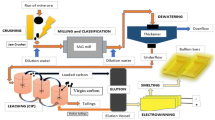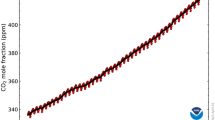Abstract
We propose a novel integrated model for the recovery of tantalum from tantalum-rich waste using a combination of hydrometallurgical and bio-metallurgical processes. To this end, leaching experiments with heterotrophs (Pseudomonas putida, Bacillus subtilis and Penicillium simplicissimum) were carried out. The heterotrophic fungal strain leached manganese with an efficiency of 98%; however, no tantalum was detected in the leachate. An unidentified species did mobilise 16% tantalum in 28 days in an experiment with non-sterile tantalum capacitor scrap. Attempts to cultivate isolate and identify these species failed. The results of a range of leaching trials resulted in an effective strategy for Ta recovery. A bulk sample of homogenised Ta capacitor scrap was first subjected to microbial leaching using Penicillium simplicissimum, which solubilised manganese and base metals. The residue was subjected to the second leach using 4 M HNO3. This effectively solubilised silver and other impurities. The residue collected after the second leach was pure tantalum in concentrated form. The hybrid model produced derives from observations from previous independent studies and shows that we can effectively recover tantalum along with silver and manganese in an efficient and environmentally friendly manner from tantalum capacitor scrap.
Graphical Abstract





Similar content being viewed by others
Data Availability
The datasets used or analysed during the current study are available in supplementary information or from the corresponding author on a reasonable request.
References
Albrecht S, Cymorek C, Andersson K, Reichert K (2011) Wolf R (2011) Tantalum and tantalum compounds. Ullmann’s Encyclopedia of Industrial Chemistry. https://doi.org/10.1002/14356007.a26_071.pub2
Angerer T, Luidold S, Antrekowitsch H (2013) Recycling potentials of the two refractory metals tantalum and niobium. Proceedings of European Metallurgical Conference (EMC2013), pp. 1069–1084
Chancerel P, Rotter VS, Ueberschaar M, Marwede M, Nissen NF, Lang K-D (2013) Data availability and the need for research to localize, quantify and recycle critical metals. Waste Manag Res 31(10 Suppl):3–16. https://doi.org/10.1177/2F0734242X13499814
Chen X (2014) Zhou T (2014) Hydrometallurgical process for the recovery of metal values from spent lithium-ion batteries in citric acid media. Waste Manag Res 321(11):1083–1093. https://doi.org/10.1177/2F0734242X14557380
CRM for EU (2017) Communication from the commission to the European parliament, the council, the European economic and social committee and the committee of the region on the 2017 list of Critical Raw Materials for the EU COM/2017/0490 final https://eur-lex.europa.eu/legal-content/EN/TXT/?uri=CELEX:52017DC0490
Cunningham L D (2001) Tantalum recycling in the United States in 1998. U.S. Department of the Interior U.S. Geological Survey. https://doi.org/10.3133/ofr01349
European Commission (2020) Critical raw materials https://ec.europa.eu/growth/sectors/raw-materials/specific-interest/critical_en
Gande VV, Vats S, Bhatt N, Pushpavanam, (2021) Sequential recovery of metals from waste printed circuit boards using a zero-discharge hydrometallurgical processes. Cleaner Eng Technol. 4:100143. https://doi.org/10.1016/j.clet.2021.100143
Gebreyohannes BG, Alberto V, Tadesse B, Yimam A, Woldetinsae G (2018) Green extraction of niobium and tantalum for Ethiopian kenticha ores by hydrometallurgy process: a review. Mater Sci Eng 2(6):315‒319 https://doi.org/10.15406/mseij.2018.02.00076
Ghambi S, Segado S, Chipakwe V, Jha Animesh (2021) An investigation on hydrofluoric (HF) acid-free extraction for niobium oxide (Nb2O5) and tantalum oxide (Ta2O5) from columbite/tantalite concentrates using alkali reductive roasting. Miner Eng 173:107183 ISSN 0892–6875 https://doi.org/10.1016/j.mineng.2021.107183
Hursthouse A, Kelly S, McPherson W et al (2018) WEEE collection and CRM recovery trials: piloting a holistic approach for Scotland. Glob NEST J 20(4):712–718 https://doi.org/10.30955/gnj.002643
Kwon S, Park S, Kim S (2016) Separation of tantalum from electronic components on laptop printed circuit board assembly. J Korean Inst Resour Recycl 25 https://doi.org/10.7844/kirr.2016.25.1.24
Liu F, Wan B, Wang F, Chen W (2019) Effect of thermal shock process on the microstructure and peel resistance of single–sided copper clad laminates used in waste printed circuit boards. J Air Waste Manag Assoc 69(12):1490–1502. https://doi.org/10.1080/10962247.2019.1674751
Mecucci A, Scott K (2002) Leaching and electrochemical recovery of copper, lead and tin from scrap printed circuit boards. J Chem Technol Biotechnol 77. https://doi.org/10.1002/jctb.575
Panias D (2006) Consequences of environmental issues on sustainability of metal industries in Europe. The case study of Bor. Metall Mater Eng Assoc Metall Eng Serbia 12(4):239–250 http://www.metalurgija.org.rs/mjom/vol12.htm
Rotter V, and Flamme S (2013) Recycling of highly functional and strategically important metals from WEEE-Current status and future perspectives. 12th International Electronics Recycling Congress IERC, Salzburg, Österreich, 16.-18.01. 2013
Sayilgan E, Kukrer T, Yigit NO, Civelekoglu G, Kitis M (2010) Acidic leaching and precipitation of zinc and manganese from spent battery powders using various reductants. J Hazard Mater 173(1–3):137–143. https://doi.org/10.1016/j.jhazmat.2009.08.063
Schwela U (2010) The state of tantalum mining. Mining Journal special publication - Tantalum (Sep), pp. 2–5
Sheng PP, Etsell TH (2007) Recovery of gold from computer circuit board scrap using aqua regia. Waste Manag Res 25 https://doi.org/10.1177/0734242X07076946
Sikander A, Kelly S, Kuchta K, Sievers A, Willner T, Hursthouse AS (2022) Chemical and microbial leaching of valuable metals from PCBs and tantalum capacitors of spent mobile phones. Int J Environ Res Public Health 19(16):10006. https://doi.org/10.3390/ijerph191610006
Sobianowska TA, Szczepaniak W, Maciejewski P, Gawlik KM (2016) Recovery of zinc and manganese, and other metals (Fe, Cu, Ni Co, Cd, Cr, Na, K) from Zn-MnO2 and Zn-C waste batteries: hydroxyl and carbonate co-precipitation from solution after reducing acidic leaching with use of oxalic acid. J Power Sources 325:220–228. https://doi.org/10.1016/j.jpowsour.2016.06.042
Spitczok von Brisinski L, Goldmann D, Endres F (2014) Recovery of metals from tantalum capacitors with ionic liquids. Chem Ing Tec 86(1–2):196–199. https://doi.org/10.1002/cite.201300059
Starck H C (2011) Elektroschrott – together we recycling succeed. In presentation slides
Ivanov I (2004) Increased current efficiency of zinc electrowinning in the presence of metal impurities by addition of organic inhibitors. Hydrometallurgy 72:73–78. https://doi.org/10.1016/S0304-386X(03)00129-4
Ueberschaar M, Jalalpoor DD, Korf N, Rotter VS (2017) Potentials and barriers for tantalum recovery from waste electric and electronic equipment. J Ind Ecol 21(3):700–714. https://doi.org/10.1111/jiec.12577
UNEP (2013) Metal recycling: opportunities, limits, infrastructure, A Report of the Working Group on the Global Metal Flows to the Inter-national Resource Panel. ISBN: 978–92–807–3267–2 Paris. https://www.resourcepanel.org/reports/metal-recycling
USGS (2017) Rare earths statistics and information. https://www.usgs.gov/centers/nmic/rare-earths-statistics-and-information
Wang Xi V, Wang L (2019) Digital twin-based WEEE recycling, recovery and remanufacturing in the background of Industry 4.0. Int J Prod Res 57:12:3892–3902 https://doi.org/10.1080/00207543.2018.1497819
Funding
This study was part sponsored by the EU LIFE-funded project “Critical Raw Material Closed Loop Recovery” coordinated by WRAP with EARN, ERP UK Ltd, KTN Ltd and Wuppertal Institute as beneficiaries. LIFE14 ENV/UK/000344.
Author information
Authors and Affiliations
Contributions
Conceptualization, AS (Asma Sikander) and KK (Kerstin Kuchta); data curation, AS, SK (Steven Kelly), KK and ASH (Andrew Hursthouse); formal analysis, AS, SK, KK and ASH; funding acquisition, KK, Anika Sievers, TW (Thomas Wilner) and ASH; investigation, AS; methodology, AS, SK, KK and ASH; project administration, KK, Anika Sievers, TW and ASH; resources, KK, TW and ASH; supervision, KK, Anika Sievers, TW and ASH; writing—original draft, AS; writing—review and editing, SK and ASH. All authors have read and agreed to the published version of the manuscript.
Corresponding author
Ethics declarations
Ethical approval
Not applicable, as there is any such content in the manuscript in relation to human participants for 493 which ethical approval is required.
Consent to participate
Not applicable, as there is no content in the manuscript in relation to human participants for which consent to participate approval is required.
Consent for publication
All the authors have their consent to publish the content, and as appropriate, copyright transfer and/or agreement of publishing the manuscript will be provided in due course. All the authors agreed and approved the final version of the manuscript.
Competing interests
The authors declare no competing interests.
Additional information
Responsible Editor: George Z. Kyzas
Publisher's Note
Springer Nature remains neutral with regard to jurisdictional claims in published maps and institutional affiliations.
Supplementary Information
Below is the link to the electronic supplementary material.
Rights and permissions
Springer Nature or its licensor (e.g. a society or other partner) holds exclusive rights to this article under a publishing agreement with the author(s) or other rightsholder(s); author self-archiving of the accepted manuscript version of this article is solely governed by the terms of such publishing agreement and applicable law.
About this article
Cite this article
Sikander, A., Kelly, S., Kuchta, K. et al. Hybrid leaching of tantalum and other valuable metals from tantalum capacitor waste. Environ Sci Pollut Res 30, 59621–59631 (2023). https://doi.org/10.1007/s11356-023-26592-3
Received:
Accepted:
Published:
Issue Date:
DOI: https://doi.org/10.1007/s11356-023-26592-3




